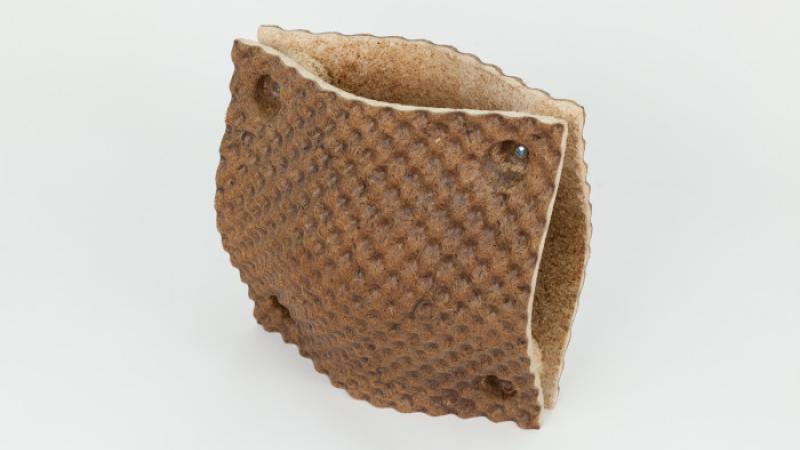September 22, 2016

Building panels made of upcycled coconut husks made a statement at the Chalewote Street Art Festival in Accra, Ghana, this summer. A kiosk constructed of the panels was featured in an online video report by MeshTV in Ghana.
“People have been amazed that coconut (husk), which is a material they think they know, can be used as a structural material, a brick, something that feels stronger than plywood, something that has resistance and strength,” Demetrios Comodromos told MeshTV. Comodromos is a professor of practice in the School of Architecture, and one of several researchers from the Rensselaer Polytechnic Institute Center for Architecture, Science, and Ecology (CASE) who have been working to develop building products from agricultural waste as a sustainable, low-energy alternative to reconstituted wood products and other materials made with synthetic adhesives.
In the video, doctoral candidate Mae-Ling Lokko pointed out the features of the kiosk, which she called “the upcycling pavilion.” The panels themselves are made of pressed coconut husk fibers and soy binders, from the company e2e Materials, on a backing of recycled burlap bags, which are used in the cocoa export industry. The kiosk also integrated materials made of plastic waste from oil gallons used by acclaimed Ghanaian artist Serge Attukwei Clottey, and recycled waste from billboards from a popular local company, “Trashy Bags.”
“We needed a panel that was really easy to assemble and a mechanism that doesn’t have many parts. This panel doesn’t use nails, we use bolts and nuts, and we assembled it pretty quickly,” Lokko told MeshTV. Based on her research, Lokko founded a company, AMBIS Technology, that will use agricultural waste materials for high-end acoustic applications.
The coconut husk building panels are one of several materials under development at CASE. In collaboration with e2e Materials, they have also investigated using coconut husk to create non-toxic wall modules and panel systems that can aid moisture control and thermal transfer in buildings.
“The coconut husk is not just any waste product; it has a lot of great properties,” said Josh Draper, an architect and clinical professor at the CASE, which hosts Rensselaer’s graduate program in Built Ecologies. “The question is, ‘what if we could take it and make it into something useful and something beautiful for our buildings?’”
Supported by numerous grants, the research has taken principal investigators and professors Comodromos, Draper, and Gustavo Crembil, Lokko, and several architecture undergraduates to Ghana several times, most recently to the Chalewote street festival. Ghana is a target country because construction is booming, building materials are largely imported, and coconut husks are commonly used in the food industry and the husk by-products are discarded.
Last semester, Crembil and Lokko also led a studio in which third- and fourth-year architecture students developed and designed a full-scale “Golden Cube” structure, which they then constructed in front of Greene Building on campus. The shed was built with custom-made cellulose (recycled paper) pressed panels using flour and starch as a binding agents. Made up of three basic types of panels following Truchet tiling patterns, the panels employ historical Ghanaian adinkra ideography organizational principles and logic to describe the shed’s social and environmental program.
The coconut panels at Chalewote were pressed into a complex geometric shape, and at this early stage of prototyping would not be cost-competitive in the Ghanaian market, said Comodromos, although there is a huge opportunity to bring down the cost structure for production. But understanding the right scale of production and being closer to the supply of husk waste, Lokko believes that they could be cost competitive with fiberboards and plywood products in Ghana.
This research, led by CASE Director Anna Dyson, fulfills the vision of The New Polytechnic, an emerging paradigm for higher education which recognizes that global challenges and opportunities are so complex, they cannot be addressed by even the most talented person working alone. Rensselaer serves as a crossroads for collaboration — working with partners across disciplines, sectors, and geographic regions, to address global challenges — and addresses some of the world’s most pressing technological challenges, from energy security and sustainable development to biotechnology and human health. The New Polytechnic is transformative in the global impact of research, in its innovative pedagogy, and in the lives of students at Rensselaer.
About Rensselaer Polytechnic Institute
Rensselaer Polytechnic Institute, founded in 1824, is America’s first technological research university. The university offers bachelor’s, master’s, and doctoral degrees in engineering; the sciences; information technology and web sciences; architecture; management; and the arts, humanities, and social sciences. Rensselaer faculty advance research in a wide range of fields, with an emphasis on biotechnology, nanotechnology, computational science and engineering, data science, and the media arts and technology. The Institute has an established record of success in the transfer of technology from the laboratory to the marketplace, fulfilling its founding mission of applying science “to the common purposes of life.” For more information, please visit http://www.rpi.edu.